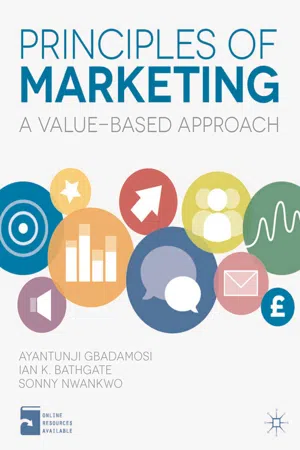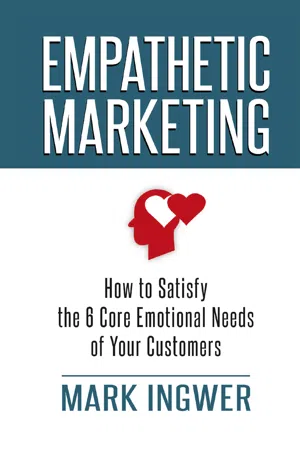Marketing
Customer Needs
Customer needs refer to the specific requirements and desires of consumers that drive their purchasing decisions. These needs can encompass functional, emotional, and social aspects, and are essential for businesses to understand in order to develop products and services that effectively meet customer demands. Identifying and addressing customer needs is a fundamental aspect of successful marketing strategies.
Written by Perlego with AI-assistance
Related key terms
1 of 5
9 Key excerpts on "Customer Needs"
- eBook - ePub
- Jim Blythe(Author)
- 2009(Publication Date)
- SAGE Publications Ltd(Publisher)
Part 3 Approaching Customers Need Satisfaction Need satisfaction is the driving force behind consumer behaviour, and the process by which marketing exchanges become successful. The marketing concept rests on the idea of satisfying Customer Needs. In fact, if customers’ needs are not satisfied they will cease to be customers – which of course, in the long run, would spell disaster for the business. In general, customers have generic needs, which marketers seek to satisfy. These are shown in Box 3.1. Box 3.1 Customer Needs Current product needs All customers for a given product have needs based on the features and benefits of the product. This also relates to the quantities they are likely to buy, and any problems they might experience with the products Future needs Predicting future demand is a key function of market research. Typically, this is carried out by talking to potential and actual customers and making an assessment of likely purchase quantities. Like any other predictions of the future, the results are unlikely to be perfect, but sales forecasting is essential if resources are to be put in place to ensure that upplies are available to meet demand. Equally, over-optimistic forecasts can result in over-supply and consequent problems in getting rid of excess product. Selling off excess product at cut prices generates problems beyond the immediate loss of profit: damage to the reputation of the brand may continue for years afterwards Desired pricing levels Customers will naturally want to buy products at the lowest possible prices. Pricing is not straightforward for marketers: it is not simply a matter of adding up what it costs to supply the product, adding on a profit margin and then selling the product. Customers will only pay what they feel is reasonable for the product, basing this on what they perceive to be the benefits they will get from buying the product - eBook - PDF
- (Author)
- 2010(Publication Date)
- Harvard Business Review Press(Publisher)
Beyond the purely physical requirements, people also need recreation, education, entertainment, and a place within a community or social status. • Wants. These are needs that are directed at specific objects that might satisfy those needs. For instance, you might need food, but for a special occasion you may want to have a meal at a restaurant rather than preparing your food at home. • Demands. These arise when people both want a specific product and are willing and able to pay for it. Demands can take several forms. For instance, “latent demand” is when customers have a strong need that can’t be satisfied by existing offerings, and “irregular demand” is when demand varies by season, day, or hour. Marketing is the whole business seen from the customer’s point of view. —Peter Drucker What Is Marketing? 9 Marketing focuses primarily on Customer Needs, since they are the underlying force for making purchasing decisions. These needs can be further broken down as follows: • Stated needs —what customers say they want; for example, “I need a sealant for my window panes for the winter.” • Real needs what customers actually require; for example, a house that is better insulated and therefore warmer during the winter. • Unstated needs —requirements that customers don’t hap-pen to mention, for example, an easy solution to insulating the house. • Delight needs —the desire for luxuries, as compared to real needs. • Secret needs —needs that customers feel reluctant to admit; for example, some people may have a strong need for social status but feel uncomfortable about admitting that status is important to them. Having a marketing orientation helps you determine what type of need is driving a customer’s demand. - eBook - PDF
Principles of Marketing
A Value-Based Approach
- Ayantunji Gbadamosi, Ian Bathgate, Sonny Nwankwo(Authors)
- 2013(Publication Date)
- Bloomsbury Academic(Publisher)
This is what makes it hugely diffi cult to define precisely. The principal diffi culty lies in the fact that the aspirations or expectations of primary marketing stakeholders (such as consumers, producers, suppliers, distributors, society) are in a perpetual state of flux and susceptible to dynamically continuous change. As the underlying aspirations or expectations change, so also does the understanding of what marketing means. To disentangle the complexity surrounding the definition of marketing, it is important first to outline its core concepts. Core concepts in marketing Figure 1.3 highlights the core concepts of marketing. An understanding of these concepts affords significant insights into how customer value might be conceived, created and delivered by a company. These core concepts include needs, wants, demand, market offering, exchange, satisfaction and profits. A brief discussion of these concepts follows. Needs: Put simply, a need can be described as the difference between a person’s current state and their desired state . We often hear people say ‘I need a car’. This simply means that the individual feels there is a discrepancy between his/her current state of not having a car (which may be a constraint to travelling around) and the desired state of acquiring one to ease travel constraints. At a most basic level, marketing is about meeting consumers’ needs. So, it resolves consumers’ state of felt deprivation Figure 1.3: Marketing value creation and delivery M A R K E T I N G M A R K E T I N G M A R K E T I N G M A R K E T I N G Value creation and delivery Market offering Profits Exchange Demand Markets Satisfaction Needs Wants 6 The Purpose of Marketing (unmet needs). Consumer needs may be categorized on two levels: primary needs (such as food and clothing) and secondary needs (for example, luxury goods such as cars, designer shoes and perfume). A popular theory of motivation, the hierarchy of needs, proposed by Abraham Maslow, can be very helpful here. - eBook - PDF
Market-Driven Management
Strategic and Operational Marketing
- Jean-Jacques Lambin, Isabelle Schuiling(Authors)
- 2012(Publication Date)
- Bloomsbury Academic(Publisher)
In B2B markets, we introduce the concept of the customer as a decision centre and we analyse the motivation of the B2B customer. 5.1 THE NOTION OF GENERIC NEED The notion of need is a term that creates endless polemic because it contains elements of subjective judgement based sometimes on morality or ideology. Beyond the vital minimum that everyone accepts – but which no one tries to define – is it really necessary to vary one’s food to satisfy taste, to travel out of curiosity or to have different hobbies? We must admit that, at least as far as consumer markets are concerned, these questions are not irrelevant, especially in view of the following facts: (a) the uninterrupted arrival of new products and brands on the market; (b) the continuous and spectacular presence of advertising in increas-ingly varied forms; and (c) the relative stability of the level of consumer satisfaction, despite CUSTOMERS’ NEEDS ANALYSIS CHAPTER FIVE Learning Objectives When you have read this chapter, you should be able to understand: The difference between generic and derived needs ■ The importance of unarticulated or latent needs ■ The determinants of well-being ■ The multi-dimensional structure of customers’ needs ■ The motivation of the B2B customer ■ The concept of industrial decision centre ■ 100 Market-Driven Management the undisputed improvement in standard of living. These facts then raise the following questions: Do all these new products and brands really correspond to pre-existing needs? ■ Would producers accept such high advertising expenditures if consumers were not ■ allowing themselves to be influenced? Is the growth and economic development that marketing claims to encourage useful ■ in the long term? Economic theory does not help to answer these questions. Economists believe it is not part of their discipline to worry about what motivates an action, or to enter into an introspection, which is always difficult, or especially to formulate a value judgement. - eBook - PDF
- T Coetsee, A Nienaber, T Coetsee, A Nienaber(Authors)
- 2014(Publication Date)
- Future Managers(Publisher)
For example, some consumers respond based on how they feel – or more emotionally, while some are focused on making the wisest economic decision. Knowing the different elements that stimulate consumer purchase activity can help marketers design appropriate sales techniques and responses. The consumer as an individual makes the decision on whether to purchase a product or not; thus the consumer is the target of marketing strategies. From an economic perspective, consumer needs control the demands for goods and services. These needs may include unique wants, wishes and desires, as well as emotional attachments towards products and services. It is important to understand what makes the individual to actually make a purchase. The needs and wants of individual consumers: • Those needs that motivate the consumer behaviour of individuals are few and basic and are not created by marketers or other social forces; they grow from their basic biological and psychological makeup as human beings. • Individuals have basic physical needs critical to their survival, such as food, drink, warmth, shelter and sleep. • They also have social and emotional needs critical to their psychological well-being, such as security, belonging, love, esteem and self-fulfilment. • The individual’s wants reflect an individual’s desire or preference for specific ways of satisfying a basic need. • Individuals’ many wants are shaped by social influences, their past history and purchasing experiences; different people may have very different wants to satisfy the same need. Satisfying the individual consumer’s needs: • Individuals use their income to satisfy their own individual needs by means of purchasing goods and services according to their own personal preferences. • The more needs people satisfy, the higher the standard of living of the individual consumer and the community where he lives. - eBook - PDF
- E. L. Cussler, G. D. Moggridge(Authors)
- 2011(Publication Date)
- Cambridge University Press(Publisher)
2 Needs Chemical product design begins by identifying Customer Needs, those unfilled wants which are the original spark for product development. The customers include both those who will buy the product and those who will use the prod-uct. Who these customers are and how their needs can be identified is the subject of Section 2.1 . These needs are the starting point for our design. Sometimes, our product will be used primarily by consumers; in this case, the needs will often be described in non-scientific terms which are hard to quantify. In Section 2.2 , we explore special problems associated with these consumer products, where we may wish to use subjectively assessed product attributes. Needs are often vague, qualitative desires for solutions to ill-defined prob-lems. To make these needs more definite, we seek particular specifications that our product must meet. Setting these specifications is explored in Section 2.3 . Usually, the specifications will require continuing revision and re-evaluation. This revision can be greatly facilitated by using “benchmarks,” which are often competing products that we hope to replace. The revision of specifications and the use of benchmarks are the topics covered in Section 2.4 . By the end of the chapter, we will have a basis from which to begin designing a successful product. 2.1 Customer Needs Elucidating Customer Needs involves three sequential steps: interviewing cus-tomers, interpreting their expressed needs, and translating these needs into prod-uct specifications. In each of these steps, we must be careful not to narrow the product definition prematurely. We will have to resist ideas from both ourselves and our colleagues, who will immediately identify potential new products and see some good ways to improve existing products. However, at this stage, we want to focus on stating a specific need, not on meeting that need. 17 - Howard R. Moskowitz, Jacqueline H. Beckley, Anna V. A. Resurreccion(Authors)
- 2012(Publication Date)
- Wiley-Blackwell(Publisher)
Move beyond the rational to the emotional . Look at emotion as a form of cognition. Psychologists who study cognition (often sensory or market researchers) have recently begun to acknowledge that emotion is a cognitive process. Both Rook and Dijksterhuis have recently written about the “intellectual tension” that still exists between the constructivist and emotionalist schools. The tension and actual conflicts oftentimes lead astray the otherwise productive discussion of testing methods. The tension moves the discussion from an in intellectual discourse about foundations to conversations about who is right versus who is wrong (Dijksterhuis, 2004; Hunt, 1994; Rook, 2003).vi. Focus on the consumer in terms of what the consumer “needs.” The concept of “need state” research is a marketing research construct. Need states came into vogue after 2005. There is little else to write about need states; the field needs much more data for general patterns to emerge.Redefining consumers, customers, needs, and wants in light of organizing principlesGiven the foregoing set of organizing principles, let us look at how consumer research is structured. This structure, consumer-centric rather than product-centric, will play an increasingly important role for marketers. The structure is also starting to play an important role for product developers working in a consumer-centric environment:i. A (customer) need is a description, in the customer's own words, of the benefit to be fulfilled by the product or service (Griffin & Hauser, 1993).ii. A (customer) want is the underlying desire for a product or service. This definition allows us to be more specific, more granular, when applying psychological theory to product development and to consumer/sensory research. Needs can be better defined and linked more closely to functional attributes. In contrast, wants link more with the emotionally based factors of products and services.iii. A consumer can be a statistic, a hypothetical figure symbolizing millions of people (Longinotti-Buitoni, 1999).iv.- eBook - PDF
Empathetic Marketing
How to Satisfy the 6 Core Emotional Needs of Your Customers
- M. Ingwer(Author)
- 2017(Publication Date)
- Palgrave Macmillan(Publisher)
Physical needs create life and keep us living, whereas the emotional needs alluded to earlier are what make life worth living. This chapter explores what those emotional needs are, how they operate, 28 ● Empathetic Marketing and how businesses can do a better job to empathize with the needs of their audience to create superior products and experiences. We can start this process by thinking about our own experiences and behavior. What drives us through life? What compels us to act in the way we act? Over the course of a day, week, month, year, and life- time, what are the psychological, emotional needs we attempt to fulfill for our own personal betterment? Human Needs Are Universal One of the most revealing studies on needs was conducted by psycholo- gist Kennon M. Sheldon of the University of Missouri Columbia in 2001. Sheldon surveyed volunteers from America and South Korea in order to identify any differences between the needs of starkly individu- alistic and collectivist cultures. It makes sense that different cultures would have different needs sets. But to his surprise, the same needs existed in each culture, despite an emphasis on different values. Sheldon and his colleagues ranked needs by analyzing memories. In one of the experiments, participants were asked to share their most satisfying event from the past week. In a second study, new participants explained their most satisfying event from the prior month. In another, they were asked to look back a few months. The participants in each experiment then evaluated and paired their stories with statements Table 2.1 Comparison American vs. - eBook - PDF
Marketing Communication NQF2 SB
TVET FIRST
- J Storer, J De Lang, A Cilliers V Williams(Authors)
- 2013(Publication Date)
- Macmillan(Publisher)
Module 14 130 130 Module 16: Potential customers’ psychological needs Overview In this module, you will... ⦁ list methods of identifying potential customer product or service needs (T5, SO3, LO1) ⦁ give reasons why it is important for the marketing department to identify Customer Needs (T5, SO3, LO2) ⦁ list the possible psychological needs customers can have (T5, SO3, LO3) ⦁ explain how the psychological needs must be taken into consideration when drafting or designing advertisements (T5, SO3, LO4) ⦁ explain how Customer Needs influence the design of advertising (T5, SO3, LO5). Module 16 131 Unit 16 .1: Methods of identifying potential customers’ product or service needs If you want to understand what someone needs, how do you find out? The first and most obvious answer to this question is, you ask people! Finding out what customers need Have you ever been in a shopping mall and been approached by someone with a clipboard and a pen who says, ‘Please can I ask you a few questions?’ This person is doing exactly what we are discussing in this unit. The person is asking you about your needs. People like this often ask you about a specific product or set of products. This is just one way for an organisation to get the information that it requires to understand the needs of its target market. It is called conducting a survey. There are many other methods that can be used in order to acquire this kind of information: Questionnaires Questionnaires are lists of questions that are carefully designed to get information that an organisation needs. Questionnaires often use a scale to find out how important something is to people. An example of a scale is as follows: XYZ deodorant keeps the body fresh the whole day: 1 = strongly disagree 2 = disagree 3 = neutral 4 = agree 5 = strongly agree Surveys Surveys are similar to questionnaires because they ask a large number of people about a particular subject using questions.
Index pages curate the most relevant extracts from our library of academic textbooks. They’ve been created using an in-house natural language model (NLM), each adding context and meaning to key research topics.








